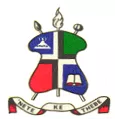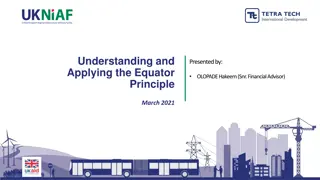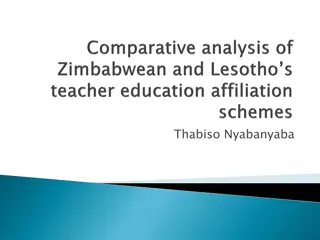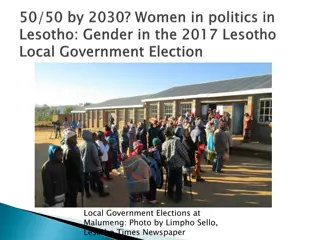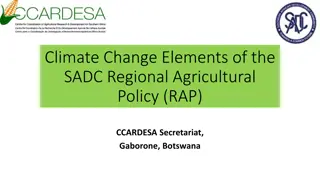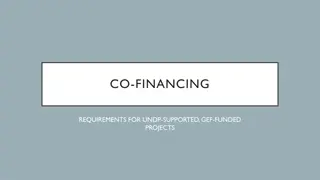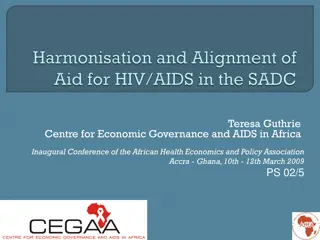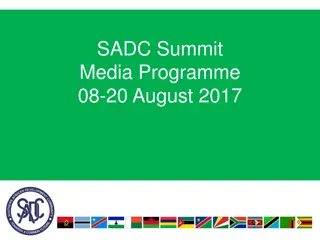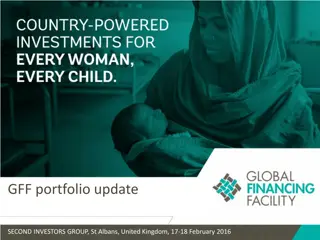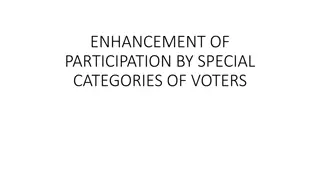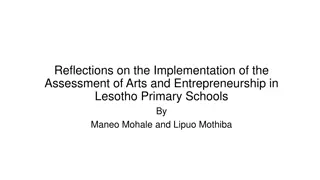Financing Higher Education in Lesotho and SADC Countries
Higher education plays a crucial role in nation-building and economic development, contributing to human capital formation, knowledge dissemination, and sustainable growth. This presentation explores the importance of financial stability and investment in higher education institutions in Lesotho and other SADC countries to address key challenges and foster economic prosperity.
Download Presentation

Please find below an Image/Link to download the presentation.
The content on the website is provided AS IS for your information and personal use only. It may not be sold, licensed, or shared on other websites without obtaining consent from the author. Download presentation by click this link. If you encounter any issues during the download, it is possible that the publisher has removed the file from their server.
E N D
Presentation Transcript
Financing Higher Education in Lesotho and a Selection of Other SADC Countries Spirit B. Tlali & Innocent Hapazari Faculty of Science & Technology National University of Lesotho Maseru, Lesotho 31st March 2016 Faculty of Science and Technology National University of Lesotho, P.O Roma 180 Lesotho, Southern Africa
Coverage The presentation will touch on: Background Higher Education Model in Botswana Higher Education Model in Namibia Higher Education Model in Swaziland Higher Education Model in Lesotho Conclusion 2 Faculty of Science and Technology
Background Why Higher Education? Higher education is central to nation building and economic development, and thus it is universally accepted that it is a critical economic engine for prosperity and growth. According to the Organization for Economic Co- operation and Development (OECD) contributions of HE to socio-economic development can be categorized into four major domains, namely: The formation of human capital (primarily through teaching and learning); The building of knowledge bases (primarily through research and knowledge development); The dissemination and use of knowledge (primarily through interactions with knowledge users); and The maintenance of knowledge (inter-generational storage and transmission of knowledge). 3 Faculty of Science and Technology
Where do we start? Financial Stability Economic Growth African Dilemma Energy crisis Food Security Political Stability
Background Contd World Bank in its 2010 report stressed that, in order for Africa, and Sub- Saharan Africa (SSA) in particular, to reap full benefits of their investment in human capital, higher education institutions (HEIs) must have sufficient finances to provide quality training and sound professional prospects to their students. To that end, HE should play a key role: in training qualified individuals, capable of implementing new technologies and using innovative methods to establish more efficient enterprises and institutions, and thus allocate resources more effectively. through research and increased knowledge to address the challenges arising from population growth, limited arable land, endemic diseases, urbanization, energy costs, and climate change. 5 Faculty of Science and Technology
Background Contd For Lesotho, provision of HE is enshrined in the country s Constitution which commits the State to ensuring that HE is made equally accessible to all, on the basis of capacity, by every appropriate means, and in particular, by the progressive introduction of free education ". In addition, the National Strategic Development Plan (NSDP) emphasizes enhancement of the skills base, technology adoption and foundation for innovation as one of the strategic goals whose attainment will ensure realization of Lesotho National Vision 2020 which states that: By the year 2020 Lesotho shall be a stable democracy, a united and prosperous nation at peace with itself and its neighbours. It shall have a healthy and well- developed human resource base. Its economy will be strong, its environment well managed and its technology well established. 6 Faculty of Science and Technology
Botswana: Background Facts about the country: Has a population of about 2.2 million GDP of 15.8 billion US dollars According to World Bank standards, it is an upper middle income country Has 10 public institutions and 5 private institutions (SARUA, 2008). However, Molutsi (2009) reported the country to have thirty-one (31) HEIs Total number of students was 47 000 in 2009 UB is the main provider of higher education The Government generally dedicates 25% of her annual national budget to education and training In 2005/06 its expenditure on HE was 9% of the country s GDP The Ministry of Education and Skills Development was allocated P10.31 billion (i.e. M14.3 billion) out of the national budget of P36.70 billion (i.e. M50.84 billion) 7 Source: World Development Indicators
Botswana: HE Funding Model Direct financial support for public HEIs At least 80% of HE operational budgets are funded by government, the rest comes from other sources mainly tuition fees The direct financial support comes in a form of government subvention, which is negotiated on the basis of institution s budgetary needs and government capacity In 2004/05 (UB, 2005), government subvention for UB was P316 million M440 million The total enrolment in the year 2004/2005 was 15,725 8 Faculty of Science and Technology
Botswana: HE Funding Model Contd Financial support for students in HE Government runs a loan/grant system Under the system the government provides sufficient tuition and maintenance financial support to every citizen who qualifies to go to university to study for a course of his or her choice The amounts payable towards support of individual students and the applicable loan/grant ratios are dependent on their programme of study. The loan/grant ratio applicable to each area of study is determined by the country s priority areas the loans versus grants ratio is based on the human resources needs of the different sectors of the economy and aims to give students an incentive to follow the areas that are considered scarce while also providing for cost recovery from higher education 9 Faculty of Science and Technology
Botswana: HE Funding Model Contd Financial support for students in HE In determining the loans versus grants ratio and the cost recovery option the country considers the following 5 categories: Category 1 comprises those areas experiencing a critical shortage of human resources. These include medicine, dentistry, engineering, professional accounting, actuarial studies, as well as certain science and technology areas. Category 2 comprise areas of human resources shortage because programmes were unattractive to students in the past. These included subjects such as Economics, Statistics, Town Planning, Chemistry and Agricultural science. Category 3 are those subjects needed to satisfy the market or balance demand and supply. These include Law, Public Administration, Journalism, Social Work and Psychology. Category 4 applies to programmes that benefit the economy and society but are less of a priority. These include Sociology, Philosophy, Museum Studies, Physical Education and Archaeology. Category 5 is for programmes that are considered to have low social benefits. These include Hairdressing, Cosmetology, Photography, Modelling, Interior Design and The Performing Arts. 10 Faculty of Science and Technology
Botswana: HE Funding Model Contd Funded items & grant-loan proportions Tuition Maintenance Category Re-payment plan % grant % loan % grant % loan 1 100 0 100 0 Employment in the country for a specified duration. 2 100 0 50 50 Employment in the country for a specified duration. Repayment of loan 3 50 50 0 100 As in category 2 4 50 50 0 100 As in category 2 5 0 100 0 100 As in category 2 11 Faculty of Science and Technology
Botswana: HE Funding Model Challenges It has been observed (SARUA, 2008) that the loan/grant scheme has not been successful in several aspects, including: Increasing enrolments and outputs of students in priority areas for example, out of a total number of 28 672 learners who enrolled for HE and received sponsorship (and 80% of them enrolled at the University of Botswana) between 1997 and 2005 only 17.5% were in Category 1, while Category 2 had 50.9%. The cost of the scheme is prohibitive when the proportion of students studying outside the country is taken into account. In 2007, 15% of the sponsored students were studying in other countries. For example, the cost of studying in the UK is about 20 to 30 times as much as studying at a private tertiary education institution in Botswana. This brings to the fore the issue of long-term sustainability of the scheme. At least up to 2008, there have been very meek efforts at recovering the costs of the loans, to the effect that in practice, students were given grants in a fully subsidised system. More effective alignment to the country s human resources needs, enforcement of loan agreements, recovery of loans from beneficiaries, and implementing effective administration and management of the scheme. Low loan repayment rates mainly due to poor information on graduates. The Ministry of Education s Department of Student Placement and Welfare has inadequate capacity and resources to trace or track the beneficiaries once they finish their studies. It has been noted that the major problem with this financing model so far has been the lack of cost recovery. In addition, there is lack of information from the demand side of the labour market as well as the absence of a national human resources database. 12 Faculty of Science and Technology
Namibia: Background Facts about the country: Has a population of about 2.4 million GDP of 13.0 billion US dollars In 2008, it had 7 public institutions and about 10 private institutions In 2014/15, the education sector was allocated M13.1 billion, accounting for 22% of the total government expenditure (Namibian Government, 2014) HE sub-sector gets at least 15% of the total budget allocation for the whole education sector 13 Faculty of Science and Technology
Namibia: HE Funding Model Of the total amount that goes towards HE, slightly over 10% goes to student support, while about 90% goes directly towards the HEIs operational and capital budgets. The student support funds are administered under the Student Financial Assistance Scheme (SARUA 2008) It has been reported that the country spent M38 000 per university student and M51 000 per vocational training student in a year (Konrad-Adenauer-Stiftung e.V., 2008). While it is not clear as to what criteria determined one s eligibility to the student support fund and the quantum of direct government support to respective HEIs, some researchers raised some concerns regarding the country s HE funding model, including: Only a few students benefited from Financial Assistance Scheme for instance, in 2002, only 40% of University of Namibia students received financial support (Marope, 2005). In 2003/04, the University and the Polytechnic, received almost 60% of the total allocation compared to teacher training and vocational education and training institutions suggesting some kind of lack of equitable distribution of government resources in HE sub-sector (Marope, 2005). The overall public spending on education and training in the country is substantially skewed in favour of the rich with about 80% of the population receiving only 40% of government subsidies (SARUA, 2008) 14 Faculty of Science and Technology
Namibia: HE Funding Model In 2013, in response to the concerns, the country came up with a formula-based funding model for her HEIs. It is based on the following four funding elements: Academic funds: The funds cover recurrent operational costs of HEIs. Major determinants are the number of programmes offered by an institution expressed in terms of standardized credit units, and the credits units are also weighted considering of field of learning and the mode of course offering full-time, part- time, distance, research, and level (Undergraduate, Masters, etc). Performance-related funds: This component serves as a motivation for institutions to align themselves with national development goals, take in disadvantaged students and dropouts, and improve the employability of students, among other considerations. Capital funds: This is provided for financing the construction of facilities and other non- recurrent developments at public HEIs. This is evaluated in the light of development objectives, appropriation of investments, as well as priorities of national objectives assigned to institutions. Competitive funding: Funds which the institutions compete on the basis of peer reviewed project proposals (Kahiurika, 2015). 15 Faculty of Science and Technology
Swaziland: Background Has a population of about 1.3 million GDP of 4.4 billion US dollars According to World Bank standards, it is classified as a lower middle income country The Ministry responsible for education is allocated 19.5% of total government budget HE expenditure generally accounts for over 20% of the total expenditure on education In 2015/16, the budget allocation for education was E2.9 billion (i.e. R2.9 billion) of which over 20% (i.e over R 600 million) went towards HE (Government of Swaziland, 2015) While the situation omay have changed, by 2007 there were 6 public funded institutions of HE UNISWA is the main provider of higher education UNISWA accounts for over 60% of the government expenditure on HE (SARUA, 2008) Facts about the country: 16 Faculty of Science and Technology
Swaziland: HE Funding Model Direct financial support for public HEIs At least 80% of HE operational budgets are funded by government, the rest comes from other sources mainly tuition fees No established model (formula) for funding HE Budget support is negotiated annually with HEIs UNISWA S government subvention in 2012/13 and 2013/14 was R242 million and R239 million respectively (UNISWA, 2014). Financial support for students in HE The government provides financial support (scholarship) to all students admitted in the country s public institutions of HE in form of grants and loans Scholarship administration is undertaken by the Scholarship Secretariat in the Ministry of Education Graduates are required to pay back the loan component of the scholarship upon completion of their studies, at an interest rate of 5% A limited number of scholarships are provided for Swazi nationals to study outside the country in priority fields (SARUA, 2008). 17 Faculty of Science and Technology
Swaziland: HE Funding Model Challenges From the sources reviewed, the Swaziland HE student funding scheme is not as elaborate as the Botswana one; e.g: It could not be established whether students are assisted by government in anyway with regard to their upkeep (maintenance costs); as such one may assume that they do not get any government support apart from tuition costs. The grant/loan proportions could also not be established either. Challenges are: Inadequate funds from government to provide scholarships to higher education students Discontinuation of capital budgeting by government, the decline in the value of grants and donor fatigue (SARUA, 2008). 18 Faculty of Science and Technology
Lesotho: Background Facts about the country: Has a population of about 1.8 million GDP of 668 million US dollars Has 8 public institutions and 6 private institutions (CHE, 2010/11-2012/13). Total number of students was 25507 in 2012 NUL, LP, LCE and LUCT are the main providers of higher education According Pundy Pillay (Study Series 2008) 40% of the education budget goes towards HE, which high by international standards 19 Faculty of Science and Technology
Lesotho: HE Funding Model Direct financial support for public HEIs All public HEIs receive direct funding from the government in the form of government subvention Currently, there is no transparent formula that is applied to determine the quantum of the subvention Ideally the public HEIs negotiate the level of subvention they require from government by submitting their budget forecasts to the Ministry of Education & Training 20 Faculty of Science and Technology
Lesotho: HE Funding Model Contd Financial support for students in HE Government runs a student bursary/loan scheme administered by the NMDS to cater for their tuition and maintenance costs Under the scheme, NMDS sets a quota of prospective students to be sponsored by Government The loan re-payment plan, which is interest free, is as follows. For those: employed by public sector, only 50% of the loan must be repaid. employed by the private sector, 65% of the loan must be repaid. working outside Lesotho, 100% of the loan must be repaid. 21 Faculty of Science and Technology
Conclusion Analysis of higher education financing models in the three SADC countries was made and compare with the funding situation in Lesotho. The following observations were made: Governments is largely responsibility for funding higher education Not all beneficiaries of higher education directly contribute towards HE funding There are variations in the levels of funding higher education in their respective countries depending on their financial situations and social peculiarities Of the four countries, Botswana has more elaborate model of funding higher education In all countries the recovery of loans is a big challenge There is a need to establish a HE funding model in Lesotho. For this purpose, a national dialogue on this issue is urgently required. 22 Faculty of Science and Technology
Thank You! Global Environment Lesotho How can we compete in the Global Market with these tools? 23
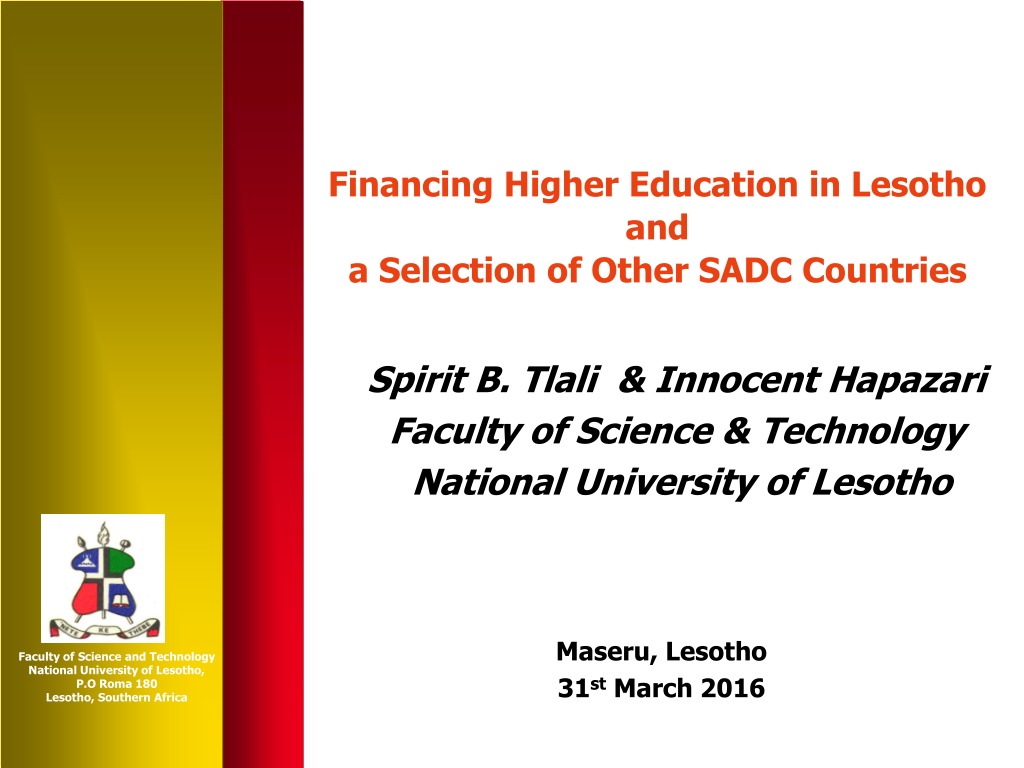
 undefined
undefined

